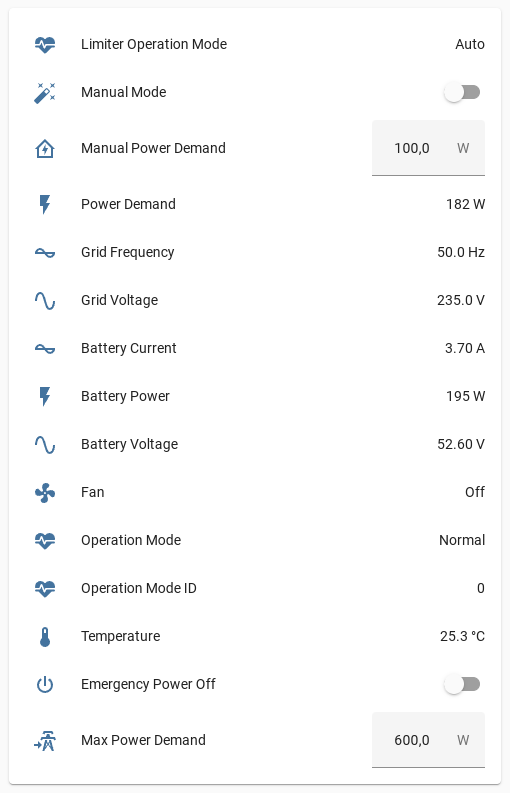ESPHome component to simulate the current clamp to control the Soyosource GTN1200 limiter
- GTN-1000LIM24, GTN-1000LIM36, GTN-1000LIM48, GTN-1000LIM72, GTN-1000LIM96
- GTN-1200LIM48, GTN-1200LIM72, GTN-1200LIM96
It looks like there is no GTW (waterproof) version of the device with limiter / RS485 support.
- ESPHome 1.18.0 or higher.
- RS485-to-TTL module (
HW-0519f.e.) - Generic ESP32 or ESP8266 board
- Required Soyosource inverter settings
- Battery CP Grid
N - Bat CP Mode Power
Upper power limit - Bat AutoLimit Grid
Y
- Battery CP Grid
RS485 UART
┌─────────┐ ┌──────────┐ ┌─────────┐
│ │ │ │<----- RX ----->│ │
│ │<-----B- ---->│ RS485 │<----- TX ----->│ ESP32/ │
│ GTN1200 │<---- A+ ---->│ to TTL │<----- GND ---->│ ESP8266 │
│ │<--- GND ---->│ module │<-- 3.3 VCC --->│ │<-- VCC
│ │ │ │ │ │<-- GND
└─────────┘ └──────────┘ └─────────┘
Please make sure to power the RS485 module with 3.3V because it affects the TTL (transistor-transistor logic) voltage between RS485 module and ESP.
You can install this component with ESPHome external components feature like this:
external_components:
- source: github://syssi/esphome-soyosource-gtn-virtual-meter@mainor just use the esp32-example.yaml / esp8266-example.yaml as proof of concept:
# Install esphome
pip3 install esphome
# Clone this external component
git clone https://github.com/syssi/esphome-soyosource-gtn-virtual-meter.git
cd esphome-soyosource-gtn-virtual-meter
# Create a secrets.yaml containing some setup specific secrets
cat > secrets.yaml <<EOF
wifi_ssid: MY_WIFI_SSID
wifi_password: MY_WIFI_PASSWORD
mqtt_host: MY_MQTT_HOST
mqtt_username: MY_MQTT_USERNAME
mqtt_password: MY_MQTT_PASSWORD
EOF
# Validate the configuration, create a binary, upload it, and start logs
# If you use a esp8266 run the esp8266-examle.yaml
esphome run esp32-example.yaml
substitutions:
name: soyosource-gtn-virtual-meter
esphome:
name: ${name}
platform: ESP32
board: esp-wrover-kit
external_components:
- source: github://syssi/esphome-soyosource-gtn-virtual-meter@main
refresh: 0s
wifi:
ssid: !secret wifi_ssid
password: !secret wifi_password
ota:
# api:
logger:
baud_rate: 0
mqtt:
broker: !secret mqtt_host
username: !secret mqtt_username
password: !secret mqtt_password
id: mqtt_client
uart:
baud_rate: 4800
tx_pin: GPIO1
rx_pin: GPIO3
soyosource_modbus:
soyosource_inverter:
soyosource_virtual_meter:
# the state of this sensor (instantaneous power in watt) is used as source
power_id: powermeter
min_power_demand: 0
max_power_demand: 1000
# A positive buffer value (10) tries to avoid exporting power to the grid (demand - 10 watts)
# A negative buffer value (-10) exports power to the grid (demand + 10 watts)
buffer: 10
binary_sensor:
- platform: soyosource_inverter
fan_running:
name: "${name} fan running"
sensor:
- platform: soyosource_virtual_meter
power_demand:
name: "${name} power demand"
- platform: soyosource_inverter
operation_mode_id:
name: "${name} operation mode id"
battery_voltage:
name: "${name} battery voltage"
battery_current:
name: "${name} battery current"
battery_power:
name: "${name} battery power"
ac_voltage:
name: "${name} ac voltage"
ac_frequency:
name: "${name} ac frequency"
temperature:
name: "${name} temperature"
# mqtt subscribe example
- id: powermeter
internal: true
platform: mqtt_subscribe
name: "${name} instantaneous power consumption"
topic: "smartmeter/sensor/groundfloor/obis/1-0:16.7.0/255/value"
accuracy_decimals: 2
unit_of_measurement: W
device_class: power
# # import smartmeter reading from homeassistant
# # requires the "api" component see above
# - platform: homeassistant
# id: powermeter
# name: "${name} smartmeter instantaneous power"
# entity_id: sensor.firstfloor_smartmeter_instantaneous_power
text_sensor:
- platform: soyosource_inverter
operation_mode:
name: "${name} operation mode"For a more advanced setup take a look at the esp32-multiple-uarts-example.yaml.
None.
If this component doesn't work out of the box for your device please update your configuration to enable the debug output of the UART component and increase the log level to the see outgoing and incoming serial traffic:
logger:
level: DEBUG
logs:
api.service: WARN
ota: WARN
sensor: DEBUG
uart:
baud_rate: 4800
tx_pin: GPIO1
rx_pin: GPIO3
debug:
direction: BOTH




